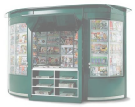© 2014-

Caroline TV (3)
Stratovision
On January 3, 1966, Broadcasting magazine reported:
Television broadcasting in South Vietnam ... begins January 21 and it's going to be done from the air. Two airplanes, circling 10,000 to 20,000 feet [3 to 6 km] above the ground, will broadcast on two TV channels—one transmitting Saigon government programmes; the other U.S. programmes. The project is being handled by the U.S. Navy. Also involved are the U.S. Information Agency and the Agency for International Development. Work on modifying two Lockheed Super Constellations has been underway by Navy electronics experts at Andrews Air Force Base ... The project is an outgrowth of a broadcasting plane used by the Navy during the Cuban and Dominican Republic crises when both radio and television were beamed to home in those countries.
The same article went on to report that during the Baseball World Series of October 1965 Stratovision had also been used to bring the games to the troops. The aircraft had picked up Voice of America radio broadcasts from California and relayed the signal to a ground broadcasting station. The Agency for International Development (AID) had purchased through the military Post Exchange Service, 1,000 monochrome, 23-
The entire project was under the control of Captain George C. Dixon, USN. He claimed to be installing AM, FM, shortwave and TV transmitters on the aircraft which would get their power from an onboard 100 kW diesel-
Ground transmissions would be received from the aircraft on TV sets tuned to channel 11 for Armed Forces Television, and channel 9 for programs in Vietnamese. On radio the broadcasts would be tuned to 1000 kHz for AM and 99.9 MHz for FM.
On 7 February 1966, Broadcasting magazine reported that after working out a number of technical problems that the first show on channel 9 would begin at 7:30 p.m. and feature South Vietnamese Prime Minister Nguyen Cao Ky and U.S. Ambassador Cabot Lodge in a videotaped production, followed by channel 11 at 8 p.m. with General Westmoreland introducing a two-
On 8 February 1966 the New York Times reported that the Vietnamese had to strain their ears because the speakers on the TV sets would need to be amplified if they were going to be heard by a room full of people watching THVN-
Other airborne TV transmissions
EC-
EC-
Today the Stratovision concept is used as a stop-
Due to the advent of fibre optic cable television systems and direct broadcast satellite services, Stratovision has become unnecessary as a permanent means of television delivery.
(Information courtesy The Early Television Museum and Wikipedia)


Click on picture to enlarge




Floor 2
Back to









